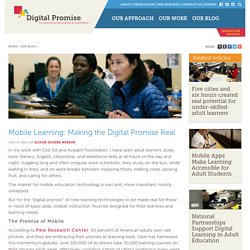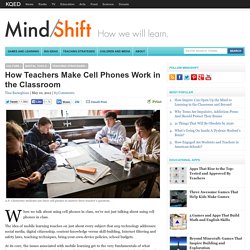

Top EdTech Update Program Evaluation Adaptive Learning Content for Wed.Jul 13, 2016. | by Alison Ascher Webber In my work with Cell-Ed and Avasant Foundation, I have seen adult learners study basic literacy, English, citizenship, and workforce skills at all hours of the day and night.

Juggling long and often irregular work schedules, they study on the bus, while waiting in lines, and on work breaks between mopping floors, milking cows, picking fruit, and caring for others. The market for mobile education technology is vast and, more important, mostly untapped. But for the “digital promise” of new learning technologies to be made real for those in need of basic skills, mobile instruction must be designed for their real lives and learning needs. The Promise of Mobile According to Pew Research Center, 92 percent of American adults own cell phones, and they are embracing their phones as learning tools. Mobile learning is also effective at reaching and teaching some of society’s hardest to serve. Working Together Toward Mobile Solutions A Mobile Learning Call to Action. How Teachers Make Cell Phones Work in the Classroom. A.P.

Chemistry students use their cell phones to answer their teacher's question. When we talk about using cell phones in class, we’re not just talking about using cell phones in class. The idea of mobile learning touches on just about every subject that any technology addresses: social media, digital citizenship, content-knowledge versus skill-building, Internet filtering and safety laws, teaching techniques, bring-your-own-device policies, school budgets. At its core, the issues associated with mobile learning get to the very fundamentals of what happens in class everyday. At their best, cell phones and mobile devices seamlessly facilitate what students and teachers already do in thriving, inspiring classrooms. In the most ideal class settings, mobile devices disappear into the background, like markers and whiteboards, pencil and paper – not because they’re not being used, but because they’re simply tools, a means to an end.
In Ramsey Musallam’s A.P. Related. How to Use Cell Phones as Learning Tools. Does your staff need Educational Technology training?

The K-12 Teachers Alliance can help you plan your in-service professional development at no additional cost. Regardless of your school’s cell phone policy, the reality in most schools is that students have phones in their pockets, purses, or hoodies. Why not get these tools out in plain sight and use them for good and not evil? Here are some easy to use strategies to use cell phones in the classrooms. Proven teaching strategies to boost your students' happiness. A few suggestions.on classroom activities that involve performance for... We point out some knowledgeable educators who quickly can become your trusted... Here are a few suggestions on how to motivate students intrinsically. Reasons why a class may be less likely to pipe up and interact during a lesson... Why Use Cell Phones as Learning Tools Cell phones are different from a computer lab filled with computers or a cart of netbooks because the cell phone is personal technology.
Mentimeter. 50 Websites Like Wiffiti. Bridge to Learning - Educational Research. We have been writing a lot about ideas on how mobile devices, and particularly phones might be used to support learning.

But most of this work has been from a somewhat theoretical angle. Now Jenny Hughes has written a great guest blog on the practical work she has been doing on the use of mobiles in schools. “I’ve been working with (primary and secondary teachers) on e-learning in the classroom – particularly the use of web 2.0 applications – as the roll out and dissemination of the TACCLE project . Part of this has been looking at the use of mobile phones as learning tools in schools.
There seems to be a lot of debate around the technology, the theoretical perspectives, the social dimension and so on but just at the moment the ‘doing’ is engaging me far more than the research. What follows is some of the output from teachers. Loss and theft and potential bullying Distraction and interruption Taking photos of tests and instantly passing them on to other pupils Spreading rumours fast.
How to Use Cell Phones as Learning Tools. An alternative to PollEverywhere or Clickers. Empowering The BYOD REVOLUTION. Audience Response Systems.